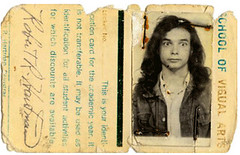Breathless — not just from the late-night climb up 11 flights to the EVO office on East 12th Street, or the astonishing art by the likes of Yossarian, Spain, Little Moon, Joe Schenkman, Brad Holland, R. Crumb, Kim Deitch, Trina Robbins, and Fred Mogubgub, or by Dean Latimer‘s gorgeous prose, or the thrill of reading Ray Schultz, or from the stunning reportage of Jackie Friedrich, Pat Morris, and Claudia Dreifus, or the amazing true life adventures of Coca Crystal (subduing a would-be attacker with a tune on her guitar) and Steve Kraus, or the Krassner interview by Kathy Streem, or the wondrous music reviews by Richard Meltzer and Charlie Frick (and Charlie’s magical layouts), or Tuli’s poetry and songs, Vincent Titus’ fables, Honest Bob Singer’s film writings, Rex Weiner’s off-off Broadway reviews (he was homeless and theaters were warm), Tim Leary’s communiqués from Algeria, A. J. Weberman‘s illuminating investigative portraits, or the vocal harmonies of Steve Heller, Latimer, and Schultz; but also from EVO’s coverage of the major events of the time: efforts to stop the Vietnam War, the Pentagon Papers, the Panther 21 trial, American Indian Movement protests, the murder of George Jackson, the Attica uprising, and Bob Dylan’s 30th birthday party, all produced at high intensity under editor Jaakov Kohn‘s benign leadership.
“EVO is not a tit!” I remember editor Allen Katzman telling several of us when salaries were slashed to the single digits, and then disappeared, during the post–salad days of the early 1970s — my tenure.
I waitressed to pay the rent on my $51-per-month apartment on East Sixth Street and to be able to eat a little more than the nightly fare of free chicken wings and chickpeas at Max’s Kansas City that many subsisted on. The EVO piece I wrote that is most remembered came out of that gig at a deli on Christopher Street when John and Yoko happened in one night and I interpreted their relationship through bits of conversation, body language, and by dissecting leftover pieces of blueberry blintz (A. J. gave me kudos for that one); it was reprinted in the Berkeley Barb and a bunch of other papers too. Read more…






